Track Multi-channel Feedback
On this page:
- Process Overview
- Check Your Channels
- Sort Your Mail Server
- Set Up a Feedback Project
- Configure the Mailbox Integration
- Create Reports
- Configure the Dashboard
- Feedback Processing in Action
- Enhancements
Thanks to our users, we receive lots of feedback each day. We receive feedback on our forum, over email, and in our issue tracker where customers can create issues and feature requests. We also get a lot of feedback over social media like Facebook, LinkedIn and Twitter. Of all these feedback channels, email and social media are the most difficult to track. It can be hard to track unanswered questions, identify who is engaged in a specific conversation, or verify who answered which question.
Another major problem with feedback is that you have no control over the type of information you receive. Many customers use their preferred channel to communicate with you. This means that you can get a lot of questions in feedback channels that should be handled by customer support. Your ability to identify these requests and bring them to the attention of a support representative can make or break your customer relations.
You can use YouTrack to monitor and process feedback. This setup helps you:
- Create issues from incoming feedback automatically.
- Monitor feedback from a variety of sources in one place.
- Categorize feedback to separate questions that require a response from spam.
- Reassign support requests that are sent to a feedback channel.
- Capture suggestions and feature requests that are sent as feedback and migrate them to your development projects.
- Ensure that you respond to feedback from all channels in a timely manner.
The goal of this setup guide is to create a dashboard that your marketing and public relations teams can use as a social media command center. This system configuration uses the following features in YouTrack:
This setup guide shows you one way to configure YouTrack to process feedback. You can always modify and enhance this configuration to suit your style. At the end of this guide, we provide some alternatives that you can consider.
Unlike the setup for using YouTrack as a help desk, we don't enable email notifications. If you enable this feature in the feedback project, you risk sending email replies to the mail server that forwards your social media notifications, not the customer who posted in the channel. The purpose of this setup is to categorize feedback and identify the questions that require follow-up. Customers who send feedback expect you to reply directly in the channel that they used to post the feedback. When you see a question that you want to answer, reply to your customers directly in the feedback channel.
Process Overview
To use a YouTrack to process feedback, follow these steps:
- Check Your Channels.
- Sort Your Mail Server
- Set Up a Feedback Project.
- Configure the Mailbox Integration.
- Create Reports.
- Configure the Dashboard.
Check Your Channels
The first step is to decide which channels you want to monitor on your dashboard. Consider all of the venues that you provide your customers for sending feedback. Gather all of the email addresses that you can use to receive notifications for each channel. Consider the following sources:
Sort Your Mail Server
Where possible, consolidate all of your email feedback on a single mail server. This may require that you update some of the email addresses that you use for notifications in different channels. If you have multiple mail servers, you can still set up connections to each server independently.
You also want to set up different folders on your mail server for each channel and route incoming messages to the folder that corresponds to each channel. This helps you track and manage feedback in each channel separately.
Get the login credentials for each mail server and make a note of the folders that are set up to collect messsages.
Set Up a Feedback Project
The project that you use to process feedback should be configured differently from a project that is used for a development team. For your marketing or public relations team, you can strip it down to the bare bones.
The configuration of the project is specific to this use case, so we describe it here in some detail.
- Click the Projects link in the header, then click the Create Project button.
- Enter a name (Feedback), and a description for the project.
- Select the project type that you want to use. Any type will work just fine, but if you select a Kanban project, YouTrack automatically creates an agile board that the marketing or public relations team can use to manage issues. This project template also uses fewer default custom fields, which makes it easier to configure.
- Click the Create project button.
- Click the Edit project link.
- Set the Project Lead.
- Click the Apply changes button.
- Select the Fields tab and configure the custom fields in the new project:
- Add members of the marketing or public relations team to the list of assignees.
- Configure the custom fields that you want to use in the project.
For feedback, you can get by with Type, Source, Priority, Assignee, and State.
The project administrator can add more custom fields as needed.
Consider using the following custom fields and values:
Custom Field Values Type Comment (positive), Comment (negative), Question, Feature, Spam Source Email, Facebook, Twitter, LinkedIn, YouTube State Unanswered (default, unresolved), Answered (resolved) - Remove any unrelated default custom fields.
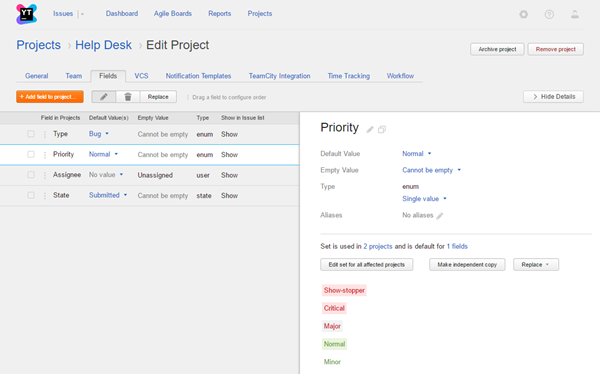
- Select the Workflow tab.
- Detach any unrelated workflows. For example, if you used the Kanban project template, you can detach the Kanban workflow. It's more appropriate for development teams, not marketing managers.
Configure the Mailbox Integration
Next, configure the mailbox integration for the feedback project. The goal of this setup is to create different mailbox rules that process messages for each channel.
- If you created separate folders for each channel on your mail server, just select the folder that stores messages by channel.
- If you don't have separate folders, you can use 'To' address to identify messages that belong to a specific channel. You can also exclude messages that match a specific pattern in the subject or body.
Keep in mind that mailbox rules are applied sequentially. Messages that match the filter that is defined in a mailbox rule are processed according to the rule and are not considered for processing in subsequent rules.
This procedure describes the basic settings that are required for this use case. There are some important settings in the Postprocessing section of the mailbox rule dialog that you can use to customize this setup.
To configure the mailbox integration:
- Open the page.
- Set the Fetching interval. The dashboard that you use to track feedback is refreshed every 10 minutes. You can use the same interval for fetching email messages from the mail server. For details, see Mailbox Integration.
- Connect to the mail server or servers that you use to receive email messages. For details, see Mailbox Integration.
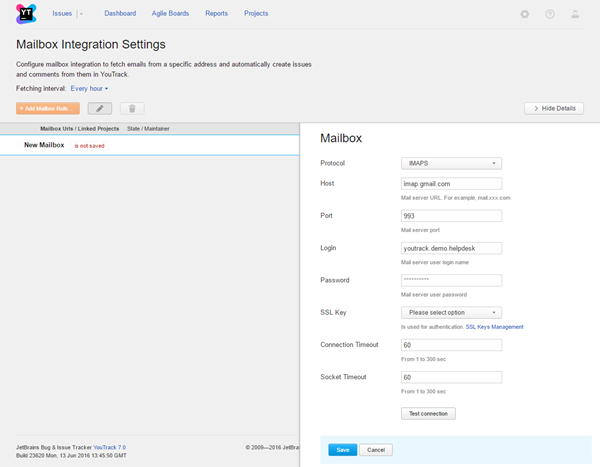
- Click the Add Mailbox Rule button and configure the following settings:
Setting Description Mailbox Select the mailbox that you connected to in step 3. Project Select the project that you configured to process feedback. 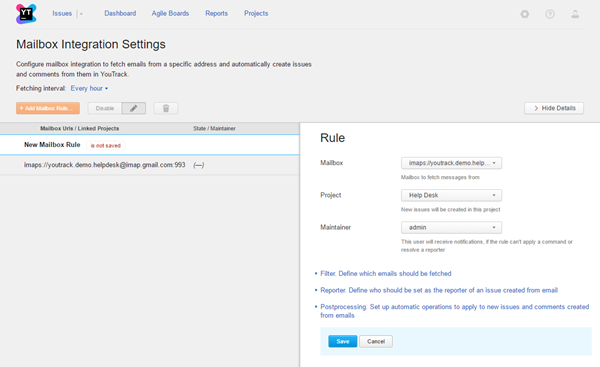
- Click to expand the Filter section and enter values for the following settings:
Setting Description Folder Select the folder from which you fetch email messages on the mail server. 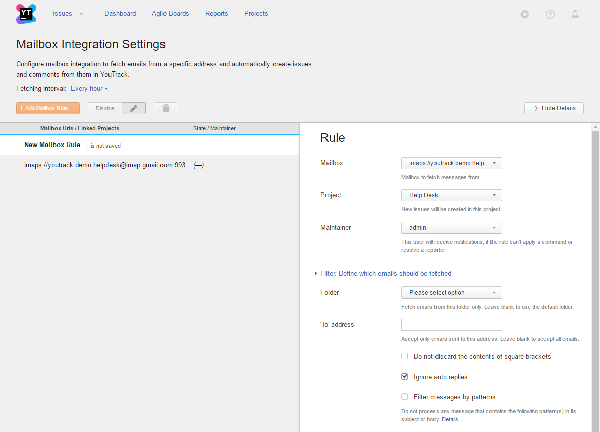
- Click to expand the Reporter section.
- Select the Always set predefined user as reporter option
and select the predefined user to set as the reporter for all issues that are created from incoming email messages.
This option guarantees that YouTrack does not create a user account for each new customer who sends a support request.
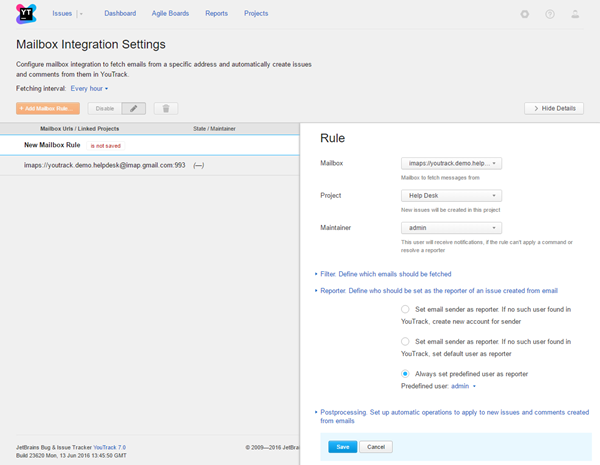
- Click to expand the Postprocessing section.
- In the Command on New Issues input field, enter a command to apply to issues that are processed by this rule.
Consider using commands that:
- Set the assignee of each issue.
- Set the value of the Source custom field to the corresponding channel.
for [user] Source Email - Click the Save button.
- Repeat steps 4 through 8 to add additional mailbox rules for each channel.
Create Reports
When you have enabled and configured the mailbox integration, the feedback that is delivered to your mail server is processed and converted into issues in YouTrack. To collect and monitor this feedback, create some reports that let you present this information in a meaningful way.
Consider the following reports:
| Report | Description |
|---|---|
| Resolved vs New/Reopened Rate | Compare the difference between the number of issues that are resolved to the number of issues that are unresolved for a specified time frame. You can set up separate reports for each channel. This lets you quickly see which channel is generating the highest number of issues. |
| Resolution Time | Track the average length of time between when issues are reported and resolved. Use this report to track all of the issues in the project and make sure you're processing feedback in a timely manner. |
| Issues per Two Fields | Display the total number of issues that are assigned to each member of the team by channel. Use this report to see which employees are engaging with customers in each channel. |
Configure the Dashboard
After you have configured the reports that you want to use, you are ready to set up the command center.
- If your YouTrack instance is connected to an external Hub service, you can configure the dashboard and share it with other users. Add report widgets for each of your reports to the dashboard and share it with the marketing or public relations team. For additional information, refer to the Hub documentation.
- If your YouTrack uses the internal Hub integration, each user configures their own personal dashboard. In this case, you can add the report widgets to your personal dashboard and share each widget with the marketing or public relations team. For more information, see Dashboard.
Here are some suggestions for widgets that you can add to create a command center:
| Type | Guideline |
|---|---|
| Wiki Notes Widgets | Add a note widget that explains the purpose of the board to new users. |
| Issue Widgets |
|
| Report Widgets | Create report widgets for each of the reports that track feedback-related activity. |
Feedback Processing in Action
Now that you've configured YouTrack for processing feedback, let's see how it works. Here is how YouTrack handles a feedback from various sources.
- You submits a comment in one of your feedback channels.
- Email feedback is sent directly to your mail server. For other channels, notification that a customer has posted feedback in the channel is forwarded to the mail server.
- The mailbox integration fetches the email messages from the mail server process them according to the defined mailbox rules.
YouTrack converts the email messages into issues.
The issue content varies by feedback source.
Source Description Email Facebook Twitter LinkedIn YouTube - The reports on the dashboard are updated to show that there are new unresolved issues.
- The marketing or public relations agent reviews each new issue and performs one of the following actions:
- The message includes marketing-related information for another product or service. The agent classifies the feedback as Spam and marks the issue as Answered. No further action is required.
- The customer left positive or negative feedback. The agent assigns the corresponding type to the issue and writes a response in the feedback channel, then copies the response as a comment in the issue and mark the issue as Answered.
- The customer suggests improvements to your product or requests functionality that is not currently available. The agent classifies the feedback as a Feature and writes a response in the feedback channel. The agent can then either mark the issue as Answered or reassign the issue to the development team.
- The customer asks a support-related question. The agent classifies the feedback as a Question and reassigns the issue to customer support.
Enhancements
If you managed to get through the basic setup, you might have done enough configuration for one day. Go ahead — get some fresh air. This page will still be here when you're ready for more.
This section describes additional features that you can set up to track feedback.
Enable Email Notifications
We told you in the introduction that we weren't going to enable this feature. That's because email notification simply doesn't work for other channels.
That said, the email notification component of the mailbox integration is a huge time saver. This lets you automatically send an email reply when you add a comment to an issue. Email replies to notifications that are sent by YouTrack are also processed and added as a comment to an original issue. Why switch to an email client when you can reply to email messages directly in an issue?
The truth is that you can enable this feature. You just can't enable it in the project that you use to process feedback for social media.
To send notifications for email feedback:
- Set up a separate feedback project for processing email only. Follow the same instructions that are described in the setup for using YouTrack as a help desk.
- Update the project settings in any mailbox rules that process email messages that are sent directly from customers.
- Update your reports and issue widgets to include issues from both the original feedback project and the new email feedback project.
Make sure that the users who work with these projects know when they can reply to feedback in an issue and when they need to switch to a specific channel and reply directly.
Attach More Workflows
We created a few workflow rules that you can use to automate feedback processing. This workflow is not available by default in YouTrack, but you can download it from the custom workflow repository and attach it to your feedback projects.
These workflow rules support the following functionality:
- Download the ZIP file from the custom workflow repository on GitHub.
- Import the workflow into the Workflow Editor. For instructions, see Import and Export Workflows in the Editor.
- Modify the workflow to match your project configuration. For instructions, see Edit a Workflow.
- Synchronize the changes in the Workflow Editor with your YouTrack server.
- Attach the workflow to your projects. For instructions, see Attach Workflows to Projects.